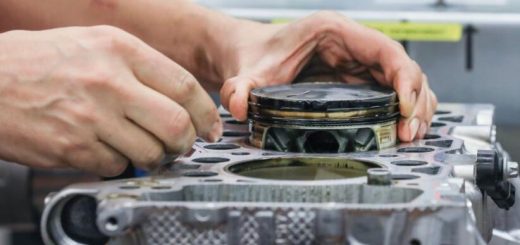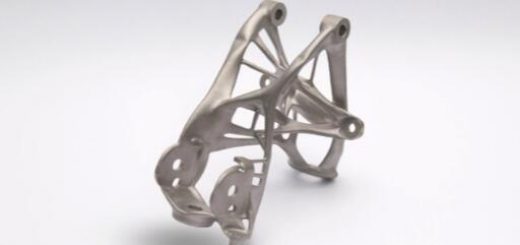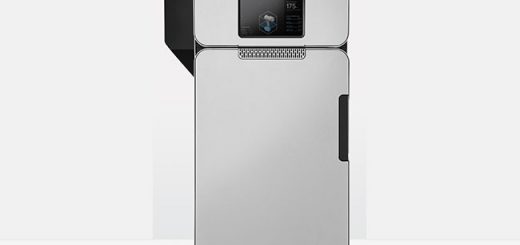WITH THE TURBO FROM THE 3D PRINTER TO 900 HP
In order to produce sand casting molds for metal casting faster and more cost-effectively, the vehicle technology manufacturer Lütgemeier GmbH relies on the VX1000 printing system from voxeljet. The 3D printing system does not only speed up the production of special components, which are used in racing cars of well-known German manufacturers. It also gives designers a whole new scope for production. The 3D printing systems from voxeljet enable time savings of up to 60 percent in the production of complex components.

Modern racing cars or performance-enhanced luxury cars offer up to 900 hp and accelerate from 0 to 100 km/h in less than four seconds. They are only capable of achieving that due to customized and finely engineered components underneath the bonnet – including specially adapted compressor housings, gearboxes, turbochargers, oil pumps and throttlebodies. These are produced by specialist manufacturers such as Lütgemeier GmbH from Steinhagen near Bielefeld in Germany. The company has been manufacturing vehicle and engine parts for renowned car manufacturers such as the high-performance tuning company BRABUS from Bottrop for more than 30 years. “We can handle the entire manufacturing process internally. Starting from the design of the component, to casting and post-processing, all the way down to assembly and quality assurance, everything happens in-house, at Lütgemeier GmbH“, says CEO Jochen Hülsmann.

The challenge: In the automotive industry, requirements and component geometries are becoming increasingly complex. The production of casting molds in which the molten metal takes on the shape of the component is thus becoming more costly and time-consuming, among other things, because an elaborate production of special tools is required. Nevertheless, in order to be able to guarantee customers flexibility and short delivery times, Lütgemeier CEO Hülsmann searched for an automation solution. He found it in voxeljet, a manufacturer of industrial 3D printing systems with its head office in Friedberg near Augsburg, Germany. Hülsmann invested in the VX1000 PDB (Phenolic Direct Binding), a professional 3D-printing system for industrial applications. Developed and manufactured in Germany, it measures 2800 x 2400 x 2300 mm and weighs 3.5 tonnes. “Having had only good experiences with the printed molds from the voxeljet service centre, we decided to invest in our own 3D printing system“, says Hülsmann. “And the VX1000 prints very reliably”. Therefore, current system utilization at Lütgemeier is one hundred percent. In peak periods of extremely high demand, Lütgemeier continues to use the proven voxeljet service in Friedberg to satisfy the demand for 3D-printed components.
3D PRINTING SYSTEM MANUFACTURES MOLDS WITHOUT THE NEED FOR SPECIAL TOOLS![]()
The VX1000 enables the automated production of sand-casting molds. The user uploads a CAD file, the digital design plans of the sand mold onto the 3D printing system. The so-called recoater then applies a layer of silica sand just 300 microns thick onto the 1000 x 600 x 500 millimetre large building platform. The print head then selectively doeses a phenolic resin based binder on those areas where the casting mold is to be produced. A to the recoater attached mobile infrared lamp then heats the building platform,in order to accelerate the curing process of the binder. After that taskthe building platform is lowered by another layer of 300µm and the process starts over and is repeated until the mold is fully constructed. “Binder jetting is the only proven and economical process for the automated production of sand-casting molds,” explains Hülsmann. After printing, an employee extracts the finished molds and removes excess silica sand with compressed air or a brush. Instead of giving the printed molds to foundries, which would again consume time, Lütgemeier GmbH casts not only lightweight alloys such as aluminium but also highly heat-resistant steels themselves in-house. In addition, the automotive specialist can also carry out the complete post-processing of the components directly. Several 5-axis milling machines as well as lathes and several measuring devices are available. Lütgemeier GmbH is thus able to produce optimized components without lengthening the supply chain by making intermediate stops.

The efficiency of this process optimization can be seen in a practical example. BRABUS has specialised in the refinement of Mercedes Benz automobiles for over 40 years. Among others, BRABUS created the BRABUS G900 based on the Mercedes AMG G 65. The built-in V12 twin turbo engine delivers an incredible 900 hp and accelerates the car to 100 km/h in just 3.9 seconds. That is supercar performance in an off-road vehicle. This is possible through the optimisation of the engine’s performance. Tailor madeturbochargers with enlarged compressor housings from Lütgemeier contribute to this enormous increase in Performance.
![]() 60% TIME SAVING IN THE PRODUCTION OF COMPLEX SAND-CASTING MOLDS
60% TIME SAVING IN THE PRODUCTION OF COMPLEX SAND-CASTING MOLDS
Hülsmann is convinced of the investment in the 3D printing system. After all, the time saved is significant. “Thanks to the printing system and the comprehensive “in-house” post-processing including quality assurance measures, we can achieve a time saving of up to 60 percent when manufacturing complex and qualitatively high-grade sand-casting molds”, says Hülsmann. Automation provides both increased flexibility and productivity and, ultimately, high levels of customer satisfaction, with components available more quickly and better than ever before “The finished cast parts are available faster and we can invest more time in the post-processing and optimization of individual components, depending on the customer’s requirements. Or simply deliver faster,” continues Hülsmann.
An advantage that has gone down well with BRABUS: “It is extremely time and cost intensive to increase the performance of an engine. The goal is to optimize the engine to maximum performance in a limited motor compartment. This is why 3D printing is the perfect solution. Through the layer-by-layer construction, we can design geometries and components which could not be produced using conventional methods,” says Jörn Gander, Director of Technology and Development at BRABUS. “The collaboration with Lütgemeier is characterized above all by the fast delivery of quality-assured and optimized components. We save on post-processing and can install the parts immediately. This is decisive for our development as well as assembly and gives us an advantage over our competitors”.
An additional benefit: The costs of producing sand-casting molds are reduced. “For complex components up to a certain batch size, 3D printing is always more favourable compared to conventional approaches due to the lack of tooling costs,” says Matthias Steinbusch, Sales Manager at voxeljet. “The smaller the batch size, the greater the cost benefit of using the voxeljet technology”. This also plays into the hands of BRABUS. The G900 model is only available 10 times in this world. A batch size in which 3D printing guarantees maximum efficiency in production.

![]() 300 DPI RESOLUTION: 3D PRINTING ENABLES FILIGREE GEOMETRIES
300 DPI RESOLUTION: 3D PRINTING ENABLES FILIGREE GEOMETRIES
Phenolic Direct Binding also enables new design possibilities. “The freedom of design is far less restricted than with conventional methods. Designers do not have to pay attention to draft angles, dividing lines or undercuts and can realize even the most filigree interior geometries,” says Steinbusch. The industrial Piezo print head of the VX1000 works with a resolution of up to 300 dpi. The unbonded silica sand is also one hundred percent recyclable in the PDB process and can be reused for the next print. A further cost benefit.
But are the 3D-printed molds really as rigid as to withstand the high casting pressure as the metal flows in? Steinbusch: “If you print very filigree coresin furanic resin, there is often a risk of breakage during casting.” Phenolic resin as a binder, , makes it possible for cores from the 3D printing system and classic mold making to achieve a higher level of stability. “The flexural strength achievable in the printing process is within the range of the strength of conventionally-manufactured cores with adjustable values between 300 and 800 N/cm2. Therefore, the 3D-printed molds are stable enough to reliably withstand the pressure of metal casting even with filigree hydraulic components”. Hülsmann is now planning an expansion thanks to the reliability of the 3D-printing system. In the future, he wants to offer the company’s services to machine manufacturers as well as vehicle manufacturers. So what can stand in the way?
Source:voxeljet




Recent Comments